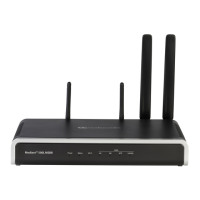User's Manual 31. SBC Overview
Version 6.8 541 Mediant 500L MSBR
31.9.2 SIP Forking Initiated by SIP Proxy Server
The device can handle SIP forking responses received from a proxy server in response to
an INVITE forwarded by the device from a UA. In other words, received responses with a
different SIP To header 'tag' parameter for the request forwarded by the device. This
occurs in scenarios, for example, where a proxy server forks the INVITE request to several
UAs, and therefore, the SBC device may receive several replies for a single request.
Forked SIP responses may result in a single SDP offer with two or more SDP answers
during call setup. The SBC handles this scenario by "hiding" the forked responses from the
INVITE-initiating UA. This is achieved by marking the UA that responded first to the INVITE
as the active UA, and only requests/responses from that UA are subsequently forwarded.
All other requests/responses from other UAs are handled by the SBC (SDP offers from
these users are answered with an 'inactive' media).
The SBC supports two forking modes, configured by the SBCForkingHandlingMode
parameter:
Latch On First - only the first received 18x response is forwarded to the INVITE
initiating UA, and disregards any subsequently received 18x forking responses (with or
without SDP).
Sequential - all 18x responses are forwarded to the INVITE initiating UA, one at a time
in a sequential manner. If 18x arrives with an offer only, only the first offer is forwarded
to the INVITE initiating UA.
The SBC also supports media synchronization for call forking. If the active UA is the first
one to send the final response (e.g., 200 OK) the call is established and all other final
responses are acknowledged and a BYE is sent if needed. If another UA sends the first
final response, then it is possible that the SDP answer that was forwarded to the INVITE-
initiating UA is not relevant, and media synchronization is needed between the two UAs.
Media synchronization is done by sending a re-INVITE request immediately after the call is
established. The re-INVITE is sent without an offer to the INVITE-initiating UA. This causes
the UA to send an offer which is forwarded to the UA that confirmed the call. The media
synchronization process is enabled by the EnableSBCMediaSync parameter.
31.9.3 Call Forking-based IP-to-IP Routing Rules
You can configure call forking routing rules in the IP-to-IP Routing table. This is done by
configuring multiple routing rules under a forking group. These rules send an incoming IP
call to multiple destinations of any type (e.g., IP Group or IP address). The device forks the
call by sending simultaneous INVITE messages to all the specified destinations. It handles
the multiple SIP dialogs until one of the calls is answered and then terminates the other
SIP dialogs. For more information, see ''Configuring SBC IP-to-IP Routing Rules'' on page
564.

